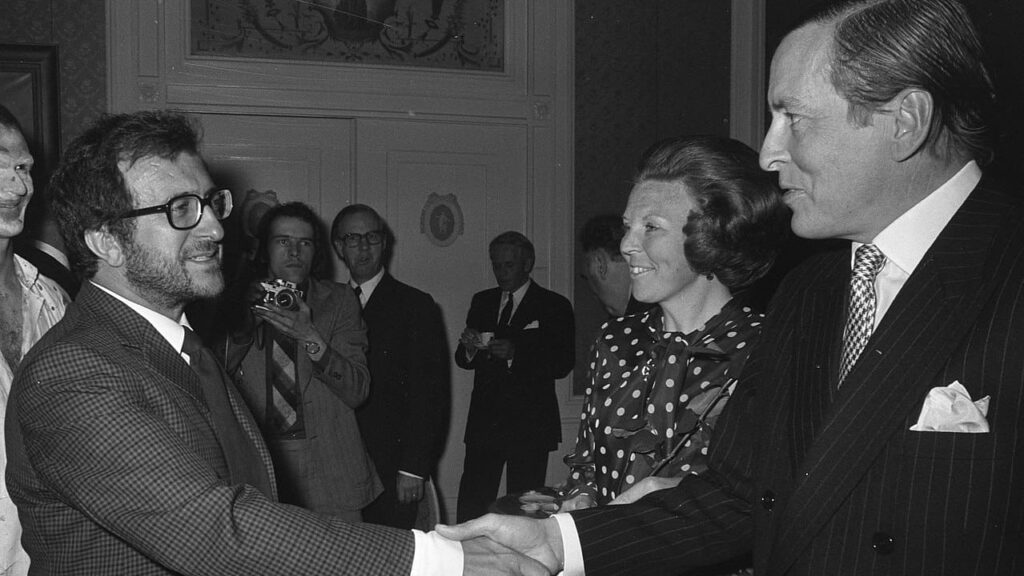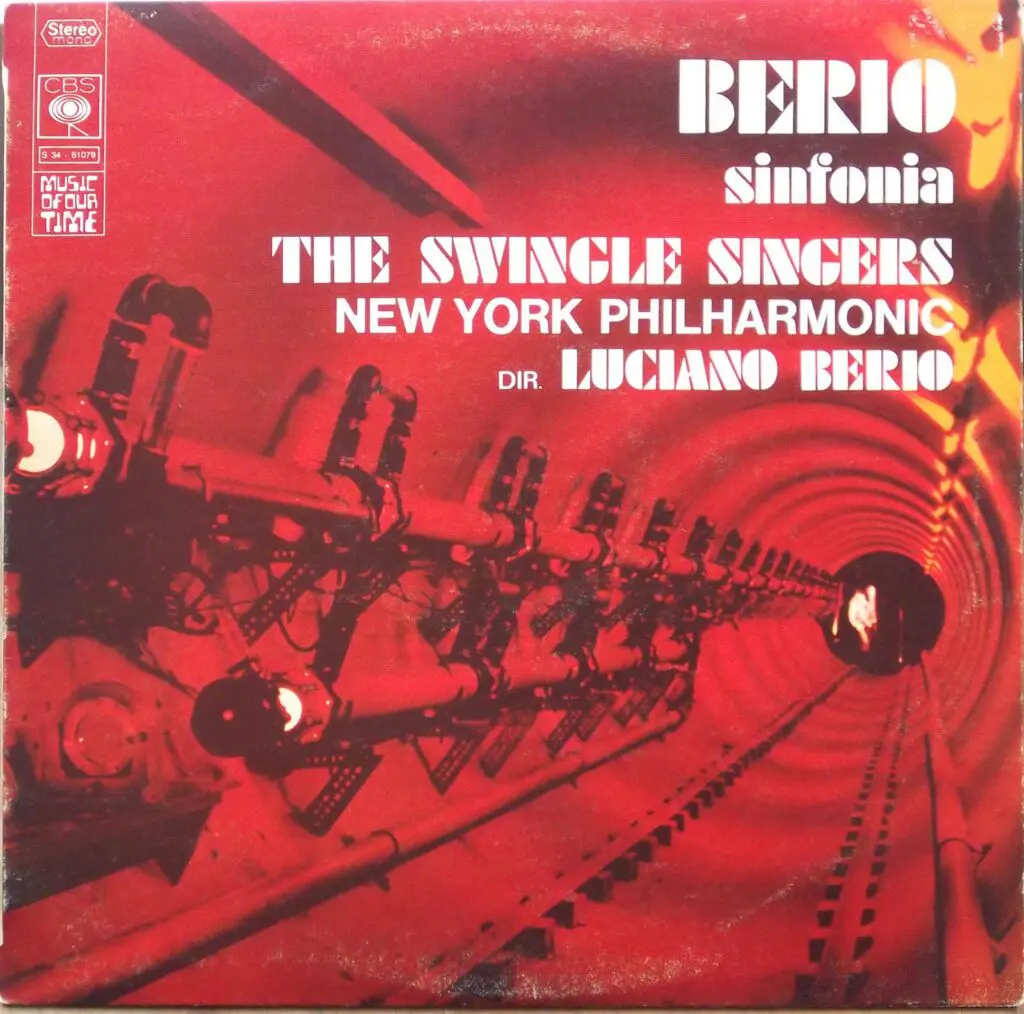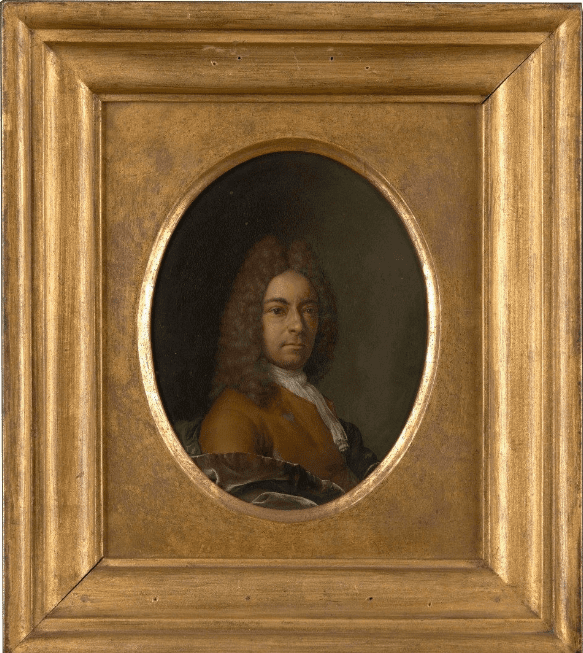
The Italian composer Luciano Berio meeting Princess Beatrix and Prince Claus of the Netherlands during the opening of the Holland Festival in the Royal Theater in The Hague, 1972.
I have spent my career debating Marxists of all shades. One small dose of Hegel and history is usually enough to sober them up. In our Gothic world of theoretical hallucinations, there is not even a chance of genuine debate. One must either consent to the hallucination or else shut up.
Those features that musicians of my generation had in common were very deep-rooted, but also very general: we were interested in the same things and we rejected broadly the same things. During the first years of the ‘Roaring Fifties,’ we shared a need to change, to clarify, to get a deeper understanding of and to develop the serialist experience. Some felt the need to reject history, others who were more responsible wanted to re-read it and not accept anything without first examining it.
—Luciano Berio: Two Interviews with Rossana Dalmonte and Bálint András Varga, ed. D. Osmond-Smith (New York/London: 1985), p. 61.
World War II left behind a devastated Europe. Cities lay in ruins, famine threatened everyone, the horrors of the Holocaust became painfully clear to more and more people. The questions of how it could have come to this and how things should continue were being asked everywhere. Also, among young composers the idea prevailed that from now on everything would have to be different. In their eyes, tradition had had its day; a radically new music was needed, free of all traditional ‘blemishes.’ Some avant-garde composers saw the solution in a music in which everything—melody, rhythm, harmony—was organised according to strict rules. In a melody, for instance, a certain pitch, after having sounded, should not be allowed to sound again until all other pitches in the octave had also been heard. So, the melody would consist of a complete series of 12 tones, hence the name dodecaphony (twelve-tone music). In the same way it is possible to organise rhythm and all kinds of other musical elements: serialism—literally the theory of serial composition—was born and would define, or at least strongly influence, musical thinking in Europe and America for decades to come. It was as if many composers regarded music as a ten-headed irrational monster that urgently needed to be tamed.
Luciano Berio (1925-2003) closely followed the latest international developments, yet he would always maintain a certain critical distance from the radical avant-garde. He believed that sounds are simply inextricably linked to a certain historical-traditional, even archetypal, meaning. Starting from a tabula rasa—a clean slate—was in his opinion neither possible nor desirable. According to Berio, the composer had no choice but also to take into account the historical connotations of certain sounds: every new piece consciously or unconsciously refers to already existing music, new music is always also ‘about’ already existing music, whether the composer acknowledges this fact or not. Moreover, Berio was inspired not only by pre-existing music, but also by the other arts, especially literature. For Berio, then, composing is more than a rationally manageable process, as he observed: “Often when a work is finished and you look at it again, to your surprise you discover things you have done unconsciously.”
In 1968-1969, Berio composed his most famous and influential work: Sinfonia for eight voices and orchestra. Numerous aspects of Sinfonia strongly antagonised the orthodox avant-gardists. While it was already ‘not the done thing’ to write a large symphony for a large symphony orchestra—the orchestra is, in the words of Berio’s pupil Louis Andriessen, at best “a historical monument of a glorious feudal past”—the many parallels with Mahler’s Symphony No.2 also raised eyebrows. After all, Mahler’s hyper-expressive music had been declared ‘dead forever’ by leading theorists in the 1950s. Although appreciation of Mahler’s music revived in the 1960s, it was still a bold step for a young composer to take the Scherzo from Mahler’s Symphony No.2 as the starting point for the third movement of a symphony, which, like Mahler’s symphony, also consists of five movements.
An awful lot has been written about why Berio did this. First and foremost: Berio loved Mahler’s music. Not for nothing did he sublimely orchestrate ten of Mahler’s Frühe Lieder later in his life. But there is more to it. Mahler himself based the Scherzo from his Symphony No.2 on a song he had composed earlier: “Des Antonius von Padua Fischpredigt.” When Saint Anthony of Padua finds his church empty, he decides to preach to the fish on the riverbank. The fish listen to him sympathetically, but then live on as before, as if nothing had happened. The song is a parodic parable about the immutability of human nature. This view, and the associated belief that life and death constitute an eternal cycle, are dominant in Berio’s Sinfonia, just as they are in Mahler’s Symphony No.2. Not for nothing is the title of the second movement “O King,” a reference to the assassination of Martin Luther King on the 4th of April, 1968. But not even greats like St. Anthony or Martin Luther King have been able to change human nature over the centuries, Berio seems to want to say. And indeed, even music “can’t stop the wars, can’t make the young older or lower the price of bread,” a reality to which the electronically amplified singing voices/speakers in Sinfonia harshly awaken us listeners.
In this way, the composer piles meaning upon meaning and allows each listener to let their own experiences and associations play along. Against this backdrop, it is not surprising that Berio himself characterised the third movement from Sinfonia as “perhaps the most experimental music I have ever written,” precisely because this movement is a kind of music-historical Noah’s Ark, in which not only Mahler, but also Beethoven, Bach, Debussy, Richard Strauss, Stravinsky, Schoenberg, Berg, Boulez, Stockhausen, and so on make a surprise appearance.
After the above, it will be clear that there is infinitely more to say about Sinfonia, but this is not the place for that. I invite everyone to listen to this exciting and complex work for themselves and then listen to it again, and then again. With each listening, you will discover new details and new meanings.

There are several brilliant recordings of Sinfonia. The composer himself conducted the first performance with the New York Philharmonic (the commissioner of the work) and The Swingle Singers on the 10th of October, 1968, a performance that was released on CBS soon after. Sinfonia then still consisted of four movements. The complete version completed in 1969, with the newly added fifth movement, was beautifully recorded, among others, by the Orchestre National de France conducted by Pierre Boulez (Erato) and by the Concertgebouw Orchestra, conducted by Riccardo Chailly (Decca).

Jan Alensoon (1683-1769) is a name hardly known even in the Netherlands today. Yet he is one of my heroes. This Leiden patrician was as fond of music as he was of Italy, which is why he left his hometown on the 5th of September, 1723, and travelled for more than a year. His main goal: to enjoy Italy and Italian vocal music, as well as Italian architecture, painting, and sculpture.
Alensoon loved to sing and did not hesitate to show his vocal skills to the greatest Italian composers and singers of his time, accompanying himself with the harpsichord. He concentrated on one piece in particular in order to impress his Italian audiences on each occasion: a cantata by the singer-organist-composer Carlo Luigi Pietragrua (ca. 1665-1726), in which the solo singer imitates a dialogue between Charon, the ferryman of the underworld (bass), and the soul of a deceased person (soprano). (As an aside, the surname Pietragrua is the Italian translation of Cranesteyn, the original name of a German immigrant who had settled in Milan around 1650!) So, the singer must be able to perform a passage in the bass register one moment, and then sing the answer an octave or two higher in a falsetto voice.

Alensoon’s surviving handwritten travel diary shows that he was in the presence of such greats as the Venetian composer Benedetto Marcello and the prima donna assoluta Faustina Bordoni, who could hold a note longer than anyone else and sing the most beautiful trills. Time and again, the Leiden dilettante noted with satisfaction that he had obtained great success with his showpiece and that he was regularly asked to sing the cantata again. Was Alensoon really a singer of stature? Perhaps less so than he himself thought. The great Roman painter and draughtsman Pier Leone Ghezzi made two fantastic caricatures of the Dutch melomaniac on the 30th of May, 1724. For one of them he provided the following caption: “the Dutch Monsieur d’Alenson who travels all over the world to seek out and hear singers and castratos, in order to learn the art of good singing. He has a split voice, you will die of laughter when you hear it. In fact, he sings bass and a high falsetto at the same time.” Perhaps Italian audience members were therefore more amused than touched or impressed by Alensoon’s singing.
And yet, what a zest for life, guts, and charm Alensoon must have radiated, because no door remained closed to him. And with what expertise he observed the Italian musical life of his time! After his return to Leiden, he would even publish a Dutch-language adaptation of Pier Francesco Tosi’s famous treatise Opinioni de’ cantori antichi e moderni (Opinions on ancient and modern singers) in 1731, long before English- and German-language editions of it appeared. How I would have liked to be Alensoon’s travelling companion, and how I would have liked to meet all these Italian luminaries in person in the wake of this Leiden patrician!
But Alensoon and I would certainly have gotten into an argument on the way back through Germany. Musical life there hardly interested him, if at all; he clearly wanted to get home to Leiden as soon as possible after leaving his beloved Turin. I would have liked a diversion over Leipzig, where Johann Sebastian Bach had started as Thomaskantor a year or so earlier. And I would not have missed Dresden for anything; after all, that city had the best orchestra in the world at the time. Or Hamburg, with its magnificent Oper am Gänsemarkt, where Telemann ruled in those years! For although, like Alensoon, I am a convinced Italophile, unlike the Leiden native, I am equally attached to the great German masters. This is probably hereditary. I got my love for melodious and passionate Italian music from my father, a Reformed minister who always speaks fondly of Rossini and Verdi, but who does not like Wagner. By contrast, my Frisian mother, who died in 2011 and had thoroughly studied piano and organ in her youth, was in holy awe of Bach, Beethoven, and Brahms, and often found Italian music too simple and banal. Somehow, I could totally understand both of them. ‘Italian’ and ‘German’ periods therefore alternate regularly in my life. After an overdose of Vivaldi, I have to reach for Bruckner. After Wagner, I try to catch my breath with Rossini.
As far as I am concerned, the German and Italian musical worlds complement each other, and they are both equally dear to me. Moreover, although there are clear orientational differences between German and Italian masters, they are often much less significant than is often claimed, especially in musicological literature in the past. It is well known how, for instance, Puccini kept a close eye on the latest developments in German music. Consider just that hyper-refined instrumental interlude with which the third act of Manon Lescaut (1893) opens. Broad Italian melodies are miraculously united here with Wagner’s revolutionary harmonic inventions. There is absolutely nothing provincial in this music; no German or French avant-gardist should have been ashamed of these notes, quite the contrary. And how interesting it is that, as far as we know, Antonio Vivaldi quoted or reused very little music by other composers but did have an outright obsession with the Imitatione delle campane (the imitation of the bells), a movement from a violin sonata by the German composer Johann Paul von Westhoff (1656-1705), which Vivaldi incorporated into at least three of his own violin concertos! Much has also been said about Dallapiccola’s orientation to the Second Viennese School (Schoenberg, Berg, and Webern), and rightly so.
In short: there is no one-way traffic. Sure, German composers often apprenticed themselves to the Italians throughout the centuries, but most Italian composers also knew exactly what their German contemporaries were doing. And so it still is: Luca Francesconi (born in 1956) for example, who is one of Italy’s leading contemporary composers, studied with Luciano Berio as well as Karlheinz Stockhausen.
Here ends the account of my trip through Italy’s musical past. I could certainly have described many more highlights. I also hope to discover many more in the future. Italian music history is a fountain that never dries up. The Austrian writer Franz Grillparzer conveyed this same feeling so eloquently in 1834, when, after hearing a performance of Emanuele d’Astorga’s Stabat mater, he wrote: “inwardly I have not been so strongly moved for a long time. Surely what men have lived in the past, when even such a person is hardly known today” (“Seit langem nicht so im Innersten ergriffen gewesen. Was haben für Männer gelebt, wenn ein solcher kaum mehr bekannt sein kann”). I could never have put it so eloquently myself.